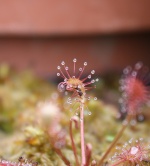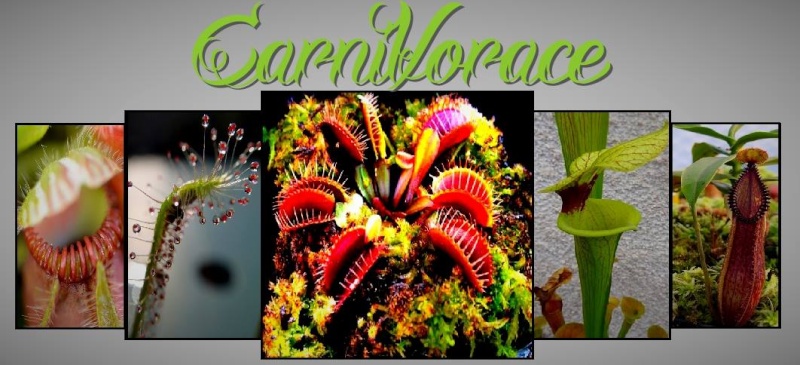| Novembre 2024 | | Lun | Mar | Mer | Jeu | Ven | Sam | Dim |
|---|
| | | | | 1 | 2 | 3 | | 4 | 5 | 6 | 7 | 8 | 9 | 10 | | 11 | 12 | 13 | 14 | 15 | 16 | 17 | | 18 | 19 | 20 | 21 | 22 | 23 | 24 | | 25 | 26 | 27 | 28 | 29 | 30 | |  Calendrier Calendrier |
|
|
| | Demandez le programme : EEE 2014 |  |
| | | Auteur | Message |
|---|
-> A.D.R <-
Admin


Messages : 3907
Date d'inscription : 02/10/2012
Age : 35
 |  Sujet: Demandez le programme : EEE 2014 Sujet: Demandez le programme : EEE 2014  Lun 30 Juin 2014 - 19:31 Lun 30 Juin 2014 - 19:31 | |
| Salut les amis,
Voici le programme des conventions de l'EEE 2014 a Padova :
Friday, September 5th 2014
16.00 - Pinguicula species from Mexico forming bulb-like winter rosettes - Oliver Gluch
In Mexico most of the tropical-heterphyllous Pinguicula species are growing in climate conditions that are characterized by a dry winter season and a rainy summer season. To survive the dry winter months most species have been adapting to these conditions by forming a winter rosette with non-carnivorous leaves. One group of species do form an onion-like winter rosette with succulent leaves that is staying during the hot and dry period under the soil surface. The author will describe distribution, will show some habitat information including accompanying Pinguicula species, will illustrate the major morphological characters and will give some cultivation experience for the species Pinguicula macrophylla, P. heterophylla, P. acuminata, P. medusina, P. parvifolia, P. oblongiloba, P. orchidioides and P. calderoniae.
Saturday, September 6th 2014
11.00 - Principles and perspectives of carnivorous plants breeding - Dr. Miroslav Srba
14.30 - Pinguicula from the Tuscan-Emilian Appenines and Apuan Alps - Giulio Pandeli
Giulio Pandeli, Coordinator of Conservation Projects of Italian Carnivorous Plant Society, reveals his first results from an 8 year census on various poorly understood species of temperate Pinguicula from the Tuscan-Emilian Appenines and Apuan Alps.
16.00 - Biblivorous plants: carnivorous plants in publishing between 19th and 20th century, with a look in modern culture - Dr. Andrea Rivolta
Growers and carnivorous plants' lovers tend to see themselves as pioneers, particularly in Italy. However, the knowledge of these plants finds many testimonies in nineteenth and twentieth centuries' publishing, both as a natural curiosity and as subjects of cultivation.
A bibliographic path is proposed, with no claim to completeness, looking for these plants until the outset of the modern book, with particular attention to the genera Dionaea and Sarracenia, not neglecting to take a look at the way cultural perception of carnivorous plants evolved to the present day, from the mythological man-eating trees up to science fiction.
17.30 - An expedition to New Guinea: the rediscovery of Nepenthes paniculata - Dr. Andreas Wistuba e Dr. Thomas Gronemeyer
New Guinea is an island of extremes: It harbors the world's largest connective rain forests, damp lowland swamps and the highest mountains in south-east Asia. Vast areas of this island are still covered with untouched wilderness.
We report on an expedition that aimed at documenting Nepenthes paniculata, a species of pitcher plant that was elusive to science for about 90 years. Furthermore we provide evidence that Nepenthes oblanceolata is a distinct species on its own and not a variety of Nepenthes maxima. Most other Nepenthes species of Papua as well as other interesting plants, such as ant plants (including a new species) and notes on land and people are presented in our lecture
Sunday, September 7th 2014
11.00 - Dr. Stewart McPherson | |
|   | | Gnömpom
Fils de nicolas Hulot

Messages : 6430
Date d'inscription : 29/10/2012
Age : 32
 |  Sujet: Re: Demandez le programme : EEE 2014 Sujet: Re: Demandez le programme : EEE 2014  Lun 30 Juin 2014 - 20:09 Lun 30 Juin 2014 - 20:09 | |
| "Demandez le traducteur" moi j'aurais dis  Merci  | |
|   | | -> A.D.R <-
Admin


Messages : 3907
Date d'inscription : 02/10/2012
Age : 35
 |  Sujet: Re: Demandez le programme : EEE 2014 Sujet: Re: Demandez le programme : EEE 2014  Lun 30 Juin 2014 - 21:17 Lun 30 Juin 2014 - 21:17 | |
| Tony, si j'avais un frere ou une soeur en CP t'aurait eu une traduction... Demande au général, il lit des livres en anglais  | |
|   | | @Luc06
Admin


Messages : 11253
Date d'inscription : 15/08/2011
Age : 38
 |  Sujet: Re: Demandez le programme : EEE 2014 Sujet: Re: Demandez le programme : EEE 2014  Lun 30 Juin 2014 - 21:20 Lun 30 Juin 2014 - 21:20 | |
| Merci ADR  | |
|   | | Sebctop
Discret


Messages : 321
Date d'inscription : 11/05/2014
Age : 52
 |  Sujet: Re: Demandez le programme : EEE 2014 Sujet: Re: Demandez le programme : EEE 2014  Mar 1 Juil 2014 - 6:37 Mar 1 Juil 2014 - 6:37 | |
| Thank you ADR !!!  | |
|   | | Gnömpom
Fils de nicolas Hulot

Messages : 6430
Date d'inscription : 29/10/2012
Age : 32
 |  Sujet: Re: Demandez le programme : EEE 2014 Sujet: Re: Demandez le programme : EEE 2014  Mar 1 Juil 2014 - 17:55 Mar 1 Juil 2014 - 17:55 | |
| | |
|   | | General Von Glop
Bavard

Messages : 704
Date d'inscription : 10/05/2014
Age : 54
 |  Sujet: Re: Demandez le programme : EEE 2014 Sujet: Re: Demandez le programme : EEE 2014  Mar 1 Juil 2014 - 22:28 Mar 1 Juil 2014 - 22:28 | |
| Suffit de demander  Il est méchant Adrien avec toi, heureusement que je suis gentil   - -> A.D.R <- a écrit:
- Salut les amis,
Voici le programme des conventions de l'EEE 2014 a Padova :
Friday, September 5th 2014
16.00 - Pinguicula species from Mexico forming bulb-like winter rosettes - Oliver Gluch
Espèces de pings du Mexique formant une rosette hivernale sous forme de pseudo bulbe
In Mexico most of the tropical-heterphyllous Pinguicula species are growing in climate conditions that are characterized by a dry winter season and a rainy summer season. To survive the dry winter months most species have been adapting to these conditions by forming a winter rosette with non-carnivorous leaves. One group of species do form an onion-like winter rosette with succulent leaves that is staying during the hot and dry period under the soil surface. The author will describe distribution, will show some habitat information including accompanying Pinguicula species, will illustrate the major morphological characters and will give some cultivation experience for the species Pinguicula macrophylla, P. heterophylla, P. acuminata, P. medusina, P. parvifolia, P. oblongiloba, P. orchidioides and P. calderoniae.
Au mexique la plupart des pings tropicales à feuilles multi forme poussent dans des conditions climatiques caractérisées par un hiver sec et une période estivale pluvieuse. Pour survivre aux mois de l' l'hiver sec la plupart des especes se sont adaptées à ces conditions en formant une rosette hivernale faite de feuilles non carnivores. Un groupe d'espèce font une rosette en forme d'oignon fait de feuilles succulentes se maintenant sous la surface le temps de la saison chaude et sèche. l'auteur décriera la distribution géographique, quelques infos concernant l'habitat inclus les espèces parmis les pings, illustrera les particularités morpho et donnera le résultat d'expériences de culture pour Pinguicula macrophylla, P. heterophylla, P. acuminata, P. medusina, P. parvifolia, P. oblongiloba, P. orchidioides and P. calderoniae.
Saturday, September 6th 2014
11.00 - Principles and perspectives of carnivorous plants breeding - Dr. Miroslav Srba
Principes et perspectives de la reproduction des carnis
14.30 - Pinguicula from the Tuscan-Emilian Appenines and Apuan Alps - Giulio Pandeli
Pings de Tuscan-Emilian Appenines et Alpes Apuan
Giulio Pandeli, Coordinator of Conservation Projects of Italian Carnivorous Plant Society, reveals his first results from an 8 year census on various poorly understood species of temperate Pinguicula from the Tuscan-Emilian Appenines and Apuan Alps.
G.P., coordinateur des projets de conservation de la société italienne des carnis révèle les premiers résultats de ses 8 première années de recensement de plusieurs espèces faiblement comprises de Pings tempérées des Tuscan-Emilian Appenines and Alpes Apuan.
16.00 - Biblivorous plants: carnivorous plants in publishing between 19th and 20th century, with a look in modern culture - Dr. Andrea Rivolta
Littérature carni: publications entres le 19eme et le 20eme avec un point sur la culture moderne.
Growers and carnivorous plants' lovers tend to see themselves as pioneers, particularly in Italy. However, the knowledge of these plants finds many testimonies in nineteenth and twentieth centuries' publishing, both as a natural curiosity and as subjects of cultivation.
Les cultivateurs et amoureux de carnis ont tendance à se considérer comme pionniers, particulièrement en Italie. Pourtant on trouve de nombreux témoignages de connaissance de ces plantes publiés aux 19eme et 20eme, comme curiosité de la nature et sujets de culture.
A bibliographic path is proposed, with no claim to completeness, looking for these plants until the outset of the modern book, with particular attention to the genera Dionaea and Sarracenia, not neglecting to take a look at the way cultural perception of carnivorous plants evolved to the present day, from the mythological man-eating trees up to science fiction.
Un chemin bibliographique est proposé, sans recherche d’exhaustivité, à la recherche de ces plantes jusqu’au début des livres modernes, avec pour sujet en particulier les dionées et Sarras, sans négliger de jeter un oeil à la façon dont la perception des carnis a culturellement évolué jusqu'à aujourd'hui, de la plante mythologique mangeuse d'homme à la science fiction.
17.30 - An expedition to New Guinea: the rediscovery of Nepenthes paniculata - Dr. Andreas Wistuba e Dr. Thomas Gronemeyer
Une expédition en Nvelle Guinée: la redécouverte de Nepenthes paniculata
New Guinea is an island of extremes: It harbors the world's largest connective rain forests, damp lowland swamps and the highest mountains in south-east Asia. Vast areas of this island are still covered with untouched wilderness.
La Nvelle Guinée est une ile des extrêmes: elle arbore la plus large forêt pluviale au monde, des marais humides de basse altitude et les montagnes les plus hautes de l'asie du SE. De vastes zones de cette ile sont toujours couvertes de nature intacte.
We report on an expedition that aimed at documenting Nepenthes paniculata, a species of pitcher plant that was elusive to science for about 90 years. Furthermore we provide evidence that Nepenthes oblanceolata is a distinct species on its own and not a variety of Nepenthes maxima. Most other Nepenthes species of Papua as well as other interesting plants, such as ant plants (including a new species) and notes on land and people are presented in our lecture
Nous restituons une expé qui avait pour but de documenter le népenthes paniculata, espèce de Neps insaisissable par la science depuis 90 ans. De plus nous donnons des preuves que Nepenthes oblanceolata est une espèce distincte à part et non une variété de
Nepenthes maxima. Nous présentons également des notes sur les paysages et populations, la plupart des espèces de Neps de Papouasie et autres plantes interessantes comme les plantes fourmis dont une nouvelle espèce.
Sunday, September 7th 2014
11.00 - Dr. Stewart McPherson | |
|   | | Po
Discret


Messages : 488
Date d'inscription : 02/06/2014
Age : 32
 |  Sujet: Re: Demandez le programme : EEE 2014 Sujet: Re: Demandez le programme : EEE 2014  Mar 1 Juil 2014 - 22:52 Mar 1 Juil 2014 - 22:52 | |
| Aha alors c'est gentil GVG  | |
|   | | General Von Glop
Bavard

Messages : 704
Date d'inscription : 10/05/2014
Age : 54
 | |   | | Contenu sponsorisé
 |  Sujet: Re: Demandez le programme : EEE 2014 Sujet: Re: Demandez le programme : EEE 2014  | |
| |
|   | | | | Demandez le programme : EEE 2014 |  |
|
Sujets similaires |  |
|
| | Permission de ce forum: | Vous ne pouvez pas répondre aux sujets dans ce forum
| |
| |
| |
